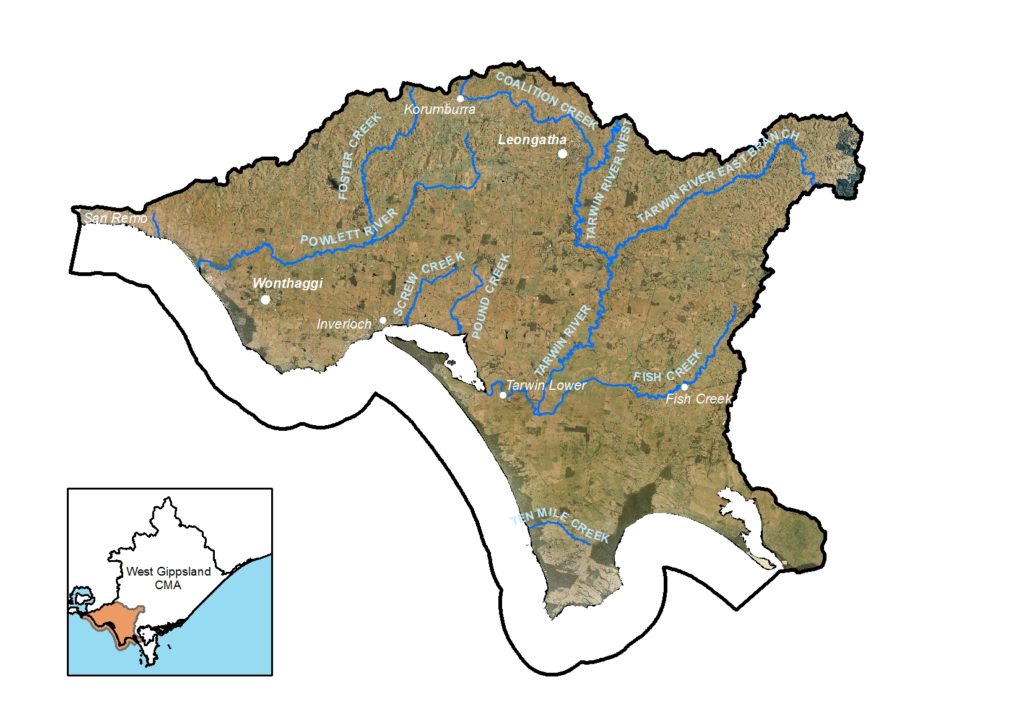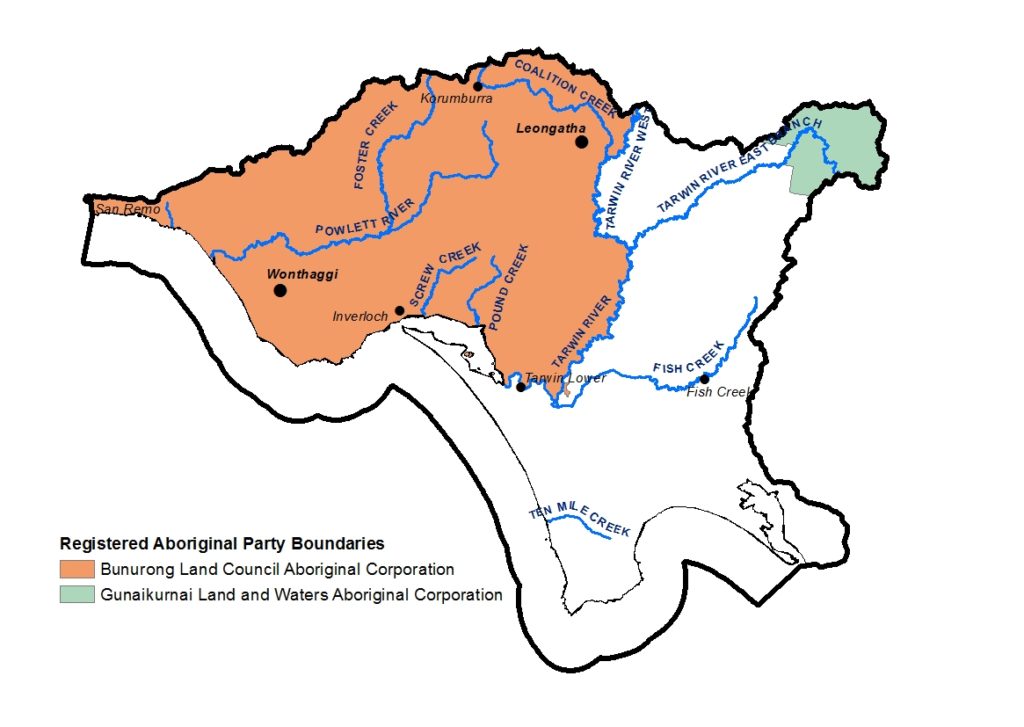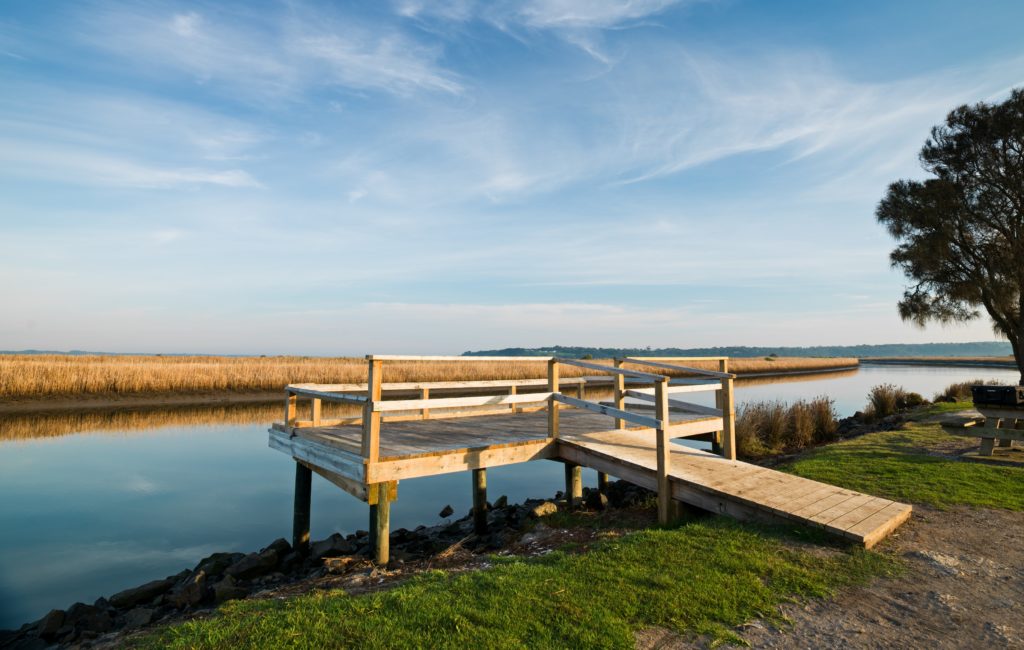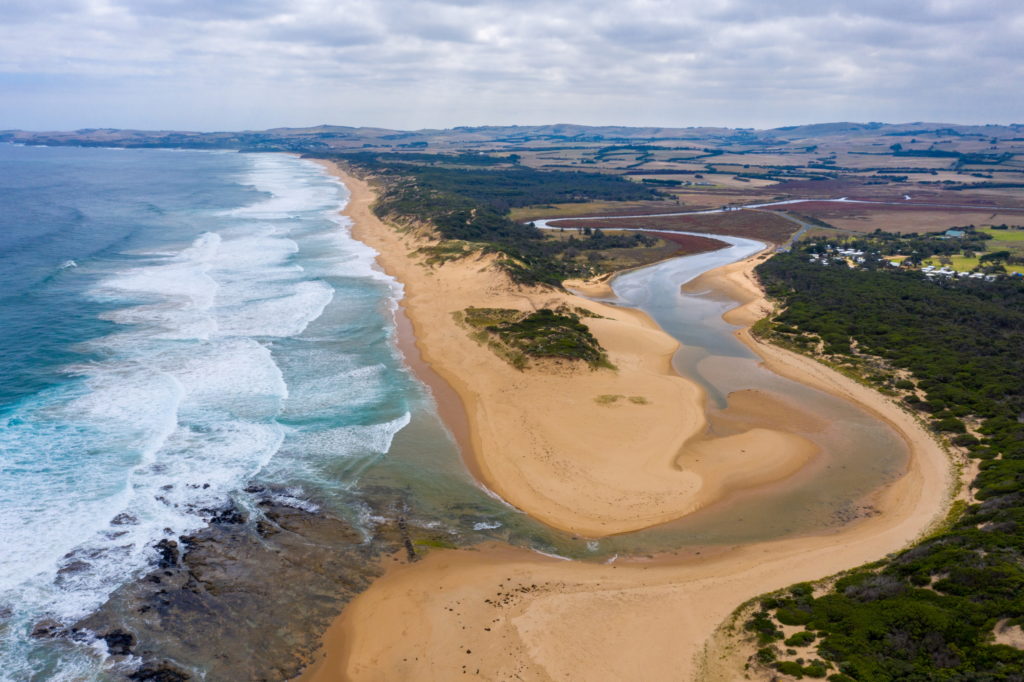Introduction
The Bunurong Coastal local area includes the Country of the Bunurong Traditional Owners and the Gunaikurnai Traditional Owners. At present, there are parts of the local area where formal recognition is not in place. Traditional Owners have a deep and continuing connection to the land and waters of the area and have an ongoing role in caring for Country.
The Bunurong Coastal local area extends from the rugged coastline and sandy inlets to the Strzelecki Ranges. Much of the area was cleared following European settlement and remaining vegetation is highly fragmented. The area has high and generally reliable rainfall providing runoff to the rivers and creeks that flow to the coast.
Major towns in the local area include Wonthaggi, Inverloch, Korumburra, Leongatha, Meeniyan and Fish Creek. The close proximity of the area to Melbourne has driven population growth in this area, resulting in development pressure and a changing demographic1.
There is a vibrant and active network of volunteers in the area and community interest in environmental stewardship is high. Landcare volunteers and groups in the local area are supported by the Bass Coast Landcare Network and the South Gippsland Landcare Network. Community led projects include long-term revegetation and weed control activities in the Powlett and Tarwin catchments and pest control and coastal adaptation projects associated with Anderson Inlet and the coast.
The major river systems in the catchment are the Tarwin River and the Powlett River. The Powlett River’s main tributary is Foster Creek. The Tarwin River divides into two branches (east and west) as well as receiving flows from its main tributaries: Coalition, Wilkur, Berrys and Fish Creeks2.
Water is a valuable resource in the catchment supporting agriculture, domestic and urban consumption and the environment. Lance Creek reservoir is an important asset supplying water to Wonthaggi, Cape Paterson, Inverloch and Korumburra. There is no environmental water held in the South Gippsland basin, however there is other water in the system that contributes to environmental outcomes3.
The Wonthaggi desalination plant is the largest in Australia and can deliver up to 150 billion litres per year to supplement Melbourne’s water supply. Improvements to South Gippsland Water’s infrastructure and connection to Melbourne’s supply system to supplement Lance Creek Reservoir has provided a more reliable supply of water, particularly during periods of drought.
The land and soils of the Tarwin and Powlett catchments are highly valued for supporting agricultural production and threatened vegetation. Whilst the soil is susceptible to acidity, it is largely intact where managed appropriately. Upper reaches of the catchment can be erosive4.
Major coastal wetlands and estuaries include the Powlett River estuary, Anderson Inlet and Shallow Inlet, all of which are listed on the Directory of Important Wetlands Australia. Shallow Inlet is an internationally important shorebird site in the East Asian-Australasian Flyway4.
The marine and coastal environment includes extensive intertidal rock platforms and sub-tidal rocky reefs, which are home to diverse ecological communities. It contains fossil sites of international and national significance and areas of cultural heritage sensitivity. The seagrass and saltmarsh communities found within the area provide habitat for migratory waders, resident birds and native fish.
The Bunurong Coastal local area contains important areas of fragmented habitat including along the Bass Coast, the Cape Liptrap Coastal Park and the Shallow Inlet barrier. These areas are valued for the recreational opportunities they provide and the threatened species they support5. Infrastructure planning for the new Yallock-Bulluk Marine and Coastal Park is currently being finalised. The park extends along 40km of coastline between San Remo and Inverloch incorporating and extending existing reserves and improving facilities and access to the coast.
In the coastal hinterland rare freshwater wetlands such as Bald Hills Wetland provide habitat connectivity and support a range of bird species and threatened vegetation communities in a largely agricultural environment. Roadside vegetation reserves also contribute to the network of native vegetation and habitat providing a framework for connecting vegetation across the landscape5.
Collaborative action for Biodiversity
The local area incorporates the Bunurong Coast and Western Strzeleckis landscape areas for Biodiversity Response Planning.
The Bunurong Coast is a focus area due to the high biodiversity values and the potential to effectively address threats to flora and fauna. The area supports an array of diverse native flora and fauna, including threatened species such as Eastern Spider-Orchid, Powerful Owl and Hooded Plover. Important vegetation communities in the priority landscape include Coastal Moonah Woodland (Flora and Fauna Guarantee Act 1988 (Victorian)) and Sub Tropical and Temperate Coastal Saltmarsh (Environment Protection and Biodiversity Conservation Act 1999 (Federal))6.
Snapshot
This section provides an overview of the local area condition and trends for RCS asset themes, including information for a selection of indicators from the state-wide outcomes framework.
Land
![]() Exposed soil ranged between 6.5% and 8.5% in South Gippsland Shire Council and 9.2% and 12.1% in Bass Coast over the period 2000-20196. The percentage of exposed soil in this local area and the region as a whole is much lower than other parts of Victoria, and is associated with the moderate climate of the area.
Exposed soil ranged between 6.5% and 8.5% in South Gippsland Shire Council and 9.2% and 12.1% in Bass Coast over the period 2000-20196. The percentage of exposed soil in this local area and the region as a whole is much lower than other parts of Victoria, and is associated with the moderate climate of the area.
![]() Non-native pasture (associated with livestock enterprises) is the dominant landcover type in the Bunurong Coastal local area (166,203 ha), followed by native trees and shrubs (15,754 ha) and irrigated horticulture (7,583 ha)7.
Non-native pasture (associated with livestock enterprises) is the dominant landcover type in the Bunurong Coastal local area (166,203 ha), followed by native trees and shrubs (15,754 ha) and irrigated horticulture (7,583 ha)7.
![]() The area of forestry, irrigated horticulture and cover by exotic woody plants increased between 1985 and 2019 as did dryland cropping and urban areas7.
The area of forestry, irrigated horticulture and cover by exotic woody plants increased between 1985 and 2019 as did dryland cropping and urban areas7.
![]() The combined production value of agriculture for the year 2015-2016 was $381M. Milk production was the major commodity followed by cattle and calves. Vegetable and hay production are also significant in the local area.
The combined production value of agriculture for the year 2015-2016 was $381M. Milk production was the major commodity followed by cattle and calves. Vegetable and hay production are also significant in the local area.
Biodiversity
![]() There was a decline in the area of native scattered trees (-78%) and native grass herb (-61%) between 1985 and 20198.
There was a decline in the area of native scattered trees (-78%) and native grass herb (-61%) between 1985 and 20198.
![]() During the same period there was an increase in natural low cover (+20%) while native shrubs and trees were relatively stable8.
During the same period there was an increase in natural low cover (+20%) while native shrubs and trees were relatively stable8.
![]() Although only representing a small proportion of the total area, there was a decline in native grasslands and seasonal and permanent wetlands8.
Although only representing a small proportion of the total area, there was a decline in native grasslands and seasonal and permanent wetlands8.
![]() 10,733 ha terrestrial and marine habitat is permanently protected through the reserve system (about 4% of the total area)11.
10,733 ha terrestrial and marine habitat is permanently protected through the reserve system (about 4% of the total area)11.
582 ha of habitat on private land was permanently protected through the establishment of Trust for Nature covenants between 2000 and 2019.
Water
The Water snapshot provides a summary from the Long Term Water Resource Assessment for Southern Victoria.
![]() 54.8GL of surface water available, is in the Powlett and 360GL in the Tarwin River system. The majority of surface water is available to the environment (Powlett -95%, Tarwin -97%). Since the Sustainable Water Strategy, the cap on the amount of unallocated surface water available for future winter-fill diversions has been revised downwards in several catchments.
54.8GL of surface water available, is in the Powlett and 360GL in the Tarwin River system. The majority of surface water is available to the environment (Powlett -95%, Tarwin -97%). Since the Sustainable Water Strategy, the cap on the amount of unallocated surface water available for future winter-fill diversions has been revised downwards in several catchments.
![]() Water availability has declined when compared with historical estimates, with the Powlett River experiencing a greater decline than the Tarwin River. Water availability has been impacted by climate change, with large scale land use changes also a potential contributor.
Water availability has declined when compared with historical estimates, with the Powlett River experiencing a greater decline than the Tarwin River. Water availability has been impacted by climate change, with large scale land use changes also a potential contributor.
![]() When conditions become drier this affects the amount of water for the environment as it is provided through ‘above cap’ water. This is the water that is left after consumptive limits have been reached. Declines in water available to the environment may have been greater if unallocated licences had been allowed to be taken up by water users.
When conditions become drier this affects the amount of water for the environment as it is provided through ‘above cap’ water. This is the water that is left after consumptive limits have been reached. Declines in water available to the environment may have been greater if unallocated licences had been allowed to be taken up by water users.
Groundwater resources include the Tarwin and Leongatha Groundwater Management Areas. Monitoring of the unconfined aquifer in these areas indicates long-term water levels have remained stable3.
Waterways and wetlands
![]() 363 km of waterway and 3,152 ha of riparian land was improved during the period 2000-2019. This included 1,542 ha weed control and 516 ha revegetation activities.
363 km of waterway and 3,152 ha of riparian land was improved during the period 2000-2019. This included 1,542 ha weed control and 516 ha revegetation activities.
![]() The area of perennial wetlands declined by 54% and seasonal wetlands by 47%, between 1985 and 20198.
The area of perennial wetlands declined by 54% and seasonal wetlands by 47%, between 1985 and 20198.
Marine and coast
![]()
![]() There was an increase in the area of mangroves (+10%) and a decrease in the area of saltmarsh (-9%) between 1985 and 20198.
There was an increase in the area of mangroves (+10%) and a decrease in the area of saltmarsh (-9%) between 1985 and 20198.
The dynamic coastline at Inverloch has been experiencing significant erosion in recent years, impacting on public access, amenity and major assets.
Community
![]() Leongatha, Inverloch and Wonthaggi are on a growth trajectory, driven by migration and development.
Leongatha, Inverloch and Wonthaggi are on a growth trajectory, driven by migration and development.
Wonthaggi is a key growth area for Bass Coast Shire and the peri-urban area around Melbourne with the population expected to increase by up to 43% for the period from 2016-361.
The Bass Coast has been declared as a distinctive area and landscape under the Planning and Environment Act 1987. This declaration requires the preparation of a Statement of Planning Policy to protect and conserve significant environmental, cultural and natural attributes from the inappropriate development.
Current and Future Challenges
![]() Key challenges in the Bunurong Coastal local area include:
Key challenges in the Bunurong Coastal local area include:
- Population pressures
- Increased recreational use and visitation
- Competition for land
- Intensification of land management practices.
These issues in combination with the history of land clearing have made parts of the catchment susceptible to erosion. Poor water quality, habitat fragmentation and degraded riparian zones have also been identified by the community and agency partners as challenges for natural resource management in this local area.
Along the coast, the combined impacts of coastal processes and climate change are a major concern to the community and agency partners. The unauthorised artificial opening of the Powlett River estuary has occurred in the past. These openings can result in a rapid change in water level with negative impacts on the health of the estuary and the flora and fauna it supports.
Responding to the impacts of climate change is a critical challenge for private landholders and agency partners.
Engaging with new farmers and residents in the area and securing sufficient funds for new and ongoing programs have been highlighted as key concerns by agency partners.
Overview of current and future management challenges for the Bunurong Coastal Local Area
| KEY MANAGEMENT CHALLENGES FOR LAND, WATER, BIODIVERSITY COAST AND MARINE | LAND | WATER | BIODIVERSITY | COAST AND MARINE | COMMUNITY CONCERNS |
|---|---|---|---|---|---|
| Altered flow regime | ✔ | ✔ | ✔ | ||
| Erosion and soil degradation | ✔ | ✔ | ✔ | ||
| Pest plants | ✔ | ✔ | ✔ | ✔ | ✔ |
| Pest animals | ✔ | ✔ | |||
| Land management practices (includes timber harvesting, land and livestock management practices) | ✔ | ✔ | |||
| Poor water quality (as the result of excess nutrients, sedimentation, oil spills and other pollutants) | ✔ | ✔ | ✔ | ✔ | |
| Recreational use and visitation impacts (includes activities and access) | ✔ | ✔ | ✔ | ||
| Population growth and urban expansion | ✔ | ✔ | ✔ | ✔ | ✔ |
| Habitat fragmentation | ✔ | ✔ | ✔ | ✔ | |
| Coastal erosion and coastal hazards | ✔ | ✔ | |||
| Climate change and related extreme events (e.g. wildfire, flood, storm surge, sea level rise) | ✔ | ✔ | ✔ | ✔ | ✔ |
Opportunities and Priorities
The Traditional Owners of this local area, the Bunurong and Gunaikurnai peoples, have cared for this Country for thousands of years. Their place-based aspirations and priorities are outlined in the Bunurong Country Plan (in preparation) and Gunaikurnai Whole of Country Plan.
There is a strong foundation of agency and community action in the Bunurong Coastal local area, with well established partnerships supporting improved land, water and biodiversity management.
The preparation of a Statement of Planning Policy (for Bass Coast) will provide the long-term direction for managing population growth and urban development pressures in the western part of the local area.
There is interest in this local area in pursuing alternative funding streams such as carbon and biodiversity credits. There are also opportunities to improve water security and address water quality concerns arising from domestic wastewater management in towns such as Dumbalk and Fish Creek.
The tables below set out the overarching Traditional Owner priorities that are relevant across all local areas and the other opportunities and priorities for agency partners and the community for this local area.
| TRADITIONAL OWNER PRIORITIES |
|---|
| ◾ Protecting cultural heritage from pressures associated recreation, land use changes and climate |
| ◾ Actively managing the water, fire, wildlife and biodiversity on Country in a culturally appropriate way |
| ◾ Having the authority to lead managing Country on behalf of the rest of the community |
| ◾ Seeking carbon production through forest restoration |
| ◾ Participating in economic opportunities, including employment and enterprise development associated with caring for Country |
| ◾ Access to water to restore customary practices, protect cultural values and uses and heal Country |
| ◾ Secure water rights to restore and reserve waterways and practice self-determination on how and where water is used for cultural, environmental or economic purposes. |
| OTHER LOCAL AREA OPPORTUNITIES AND PRIORITIES |
|---|
| ◾ Prevent further loss of biodiversity through permanent protection and targeted actions to reduce threats |
| ◾ Implement local Biolink priorities across private and public land including through the use of roadside and linear corridors |
| ◾ Implement an evidence-based approach to respond to issues of erosion and inundation facing the Inverloch community |
| ◾ Increase the focus on the Tarwin – Anderson Inlet catchment and continue to progress Integrated Catchment Management in the Powlett River Catchment |
| ◾ Investigate and implement planning scheme measures to manage potential impacts from development / population growth on agricultural land, wetlands, water quality and biodiversity |
| ◾ Recognise and support citizen scientists and the data they collect in informing management decision |
| ◾ Support community participation with a broader range of groups and individuals |
| ◾ Work together to understand and implement climate change adaptation priorities at the local scale |
| ◾ Support farmers to implement practices that improve land management and reduce off-site impacts |
| ◾ Support Traditional Owners’ aspirations for and participation in land, water and biodiversity management |
| ◾ Investigate and implement options to address water recovery targets (for Traditional Owner, environmental and recreational values) |
| ◾ Complete works to protect and rehabilitate waterways and riparian areas. |
Community perspectives
What does the Bunurong Coastal Landscape look like in the future?
“Connectedness! Corridors all along the Tarwin River from the headwaters to coast. Clean waterways.”
“If you had a microscope you would see each of the farms was carbon neutral.”
“A lot more visitors and we will need to give them an action to take.”
“Green vegetated view, shelterbelts, gullies, clean oceans, contained urban areas.”
The top land, water and biodiversity management actions identified by community members were:
- Retain and restore native vegetation communities
- Control invasive plants (e.g. willow, ragwort, serrated tussock, mirror bush)
- Fencing of waterways and native vegetation
- Support agricultural practices that improve soil health, productivity and water use efficiency
- Improve our knowledge of land, water and biodiversity and the effectiveness of our actions.
The top areas of focus for climate change adaptation were:
- Maintain a diversity of habitats, environments and species to maximise the chance of survival
- Increase carbon sequestration through activities such as revegetation and soil improvement
- Incorporate climate change projections in land-use planning and development.
The top areas for helping communities and industries to participate in land, water and biodiversity management were:
- Collaboration between agencies and community/industry on projects at a local level
- Information/advice to improve knowledge
- Grants or incentives to undertake projects.
Management Directions and Regional Outcomes
Management directions are the overarching strategies to guide agency and community collaboration. The agency and community priorities outlined above will help to realise the management directions at the local area scale.
Implementation will be guided by regular local area partnership forums and implementation planning processes that prioritise effort with consideration to value for money, and issues of feasibility and risk.
Priority management directions have been defined for each theme: Land, Water, Biodiversity, Coastal and Marine, Traditional Owners, Community and Climate Change.
The RCS outcomes hierarchy can be found here with a more detailed matrix showing how the medium term outcomes align to local areas here.
Further details on RCS implementation can be found here.
References
- RMCG. West Gippsland Regional Catchment Strategy Review and Renewal Report. Prepared by RMCG for the West Gippsland Catchment Management Authority, 2020
- Zavadil, E & Ferguson, C. Bunurong Catchment Ecosystem Strategic Directions Statement. Report. Prepared by Alluvium for the West Gippsland Catchment Management Authority, 2010
- DELWP. Long Term Water Resource Assessment for Southern Victoria. Basin by Basin Results. East Melbourne: Department of Environment, Land, Water and Planning, 2020
- WGCMA. West Gippsland Regional Catchment Strategy 2013-2019. Traralgon: West Gippsland Catchment Management Authority, 2013
- BCSC. Biodiversity Biolinks Plan 2018. Wonthaggi: Bass Coast Shire Council, 2018
- DELWP. Biodiversity Response Planning Fact Sheets. Department of Environment, Land, Water and Planning. [Online] 2021
- Van Dijk, A and Summers, David. Australia’s Environment Explorer, The Australian National University. Exposed Soil. [Online] 27 November 2020
- DELWP. Victorian Land Cover Time Series Data 1985-2019. East Melbourne: Department of Environment, Land, Water and Planning, 2020a
- ABS. Agricultural Census: Agricultural Data – 2005-06, 2010-11 and 2015-16. Canberra: Australian Bureau of Statistics, 2020
- BLCAC. Bunurong Land Council Aboriginal Corporation Appointed Registered Aboriginal Parties Area. Frankston: Bunurong Land Council Aboriginal Corporation, Undated
- DAWE. Collaborative Australian Protected Areas Database (CAPAD) – Terrestrial & Marine. [Spatial Layer] Canberra: Department of Agriculture, Water and the Environment, 2021.







